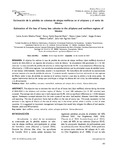
Please use this identifier to cite or link to this item:
http://ricaxcan.uaz.edu.mx/jspui/handle/20.500.11845/913Full metadata record
| DC Field | Value | Language |
|---|---|---|
| dc.contributor | 111167 | es_ES |
| dc.creator | Medina Flores, Carlos Aurelio | - |
| dc.creator | Esquivel Marín, Nancy Harlet | - |
| dc.creator | López Carlos, Marco Antonio | - |
| dc.creator | Medina Cuéllar, Sergio Ernesto | - |
| dc.creator | Aguilera Soto, Jairo Iván | - |
| dc.date.accessioned | 2019-04-01T19:42:14Z | - |
| dc.date.available | 2019-04-01T19:42:14Z | - |
| dc.date.issued | 2018 | - |
| dc.identifier | info:eu-repo/semantics/publishedVersion | es_ES |
| dc.identifier.issn | 2007-901X | es_ES |
| dc.identifier.uri | http://localhost/xmlui/handle/20.500.11845/913 | - |
| dc.description | The objective was to estimate the rate of loss of honey bee (Apis mellifera) colonies during the winter of 2015-2016 in the altiplano and northern regions of Mexico. In total, 196 beekeepers (n=41907 colonies) were surveyed. The average rate of colony loss in both regions was 33.4%, with no significant differences (p>0.05) between regions. Beekeepers surveyed estimate that the main causes of loss were: bad weather, diseases, insecticides, evasion and swarming. the size of apicultural farms had no effect on the rate of colony loss. This study represents the first estimate in two regions of Mexico of the rate of colony loss in the winter period, which is similar to that of other countries. It is suggested to implement management techniques that would help mitigate the effects of bad weather, diseases, pests and Africanization. | es_ES |
| dc.description.abstract | El objetivo fue estimar la tasa de pérdida de colonias de abejas melíferas (Apis mellifera) durante el invierno de 2015-2016 en las regiones del altiplano y norte de México. Se encuestaron 196 apicultores (n=41907 colonias), La tasa promedio de pérdida de colonias en ambas regiones fue del 33.4%, no se presentaron diferencias significativas (p>0.05) entre regiones. Los apicultores encuestados estiman que las principales caudas de pérdida fueron: el mal tiempo, enfermedades, insecticidas, evasión y la enjambrazón. No hubo efecto del tamaño de las explotaciones apícolas respecto a la tasa de pérdida de colonias. El presente estudio representa la primer estimación en dos regiones de México sobre la tasa de pérdida de colonias en el periodo invernal y que ésta es similar a los otros países. Se sugiere implementar técnicas de manejo que contribuyan a mitigar los efectos del mal clima, las enfermedades, plagas y la africanización. | es_ES |
| dc.language.iso | spa | es_ES |
| dc.publisher | Universidad Juárez Autónoma de Tabasco | es_ES |
| dc.relation.ispartof | http://dx.doi.org/10.19136/era.a5n14.1459 | es_ES |
| dc.relation.uri | generalPublic | es_ES |
| dc.rights | Atribución-NoComercial-CompartirIgual 3.0 Estados Unidos de América | * |
| dc.rights.uri | http://creativecommons.org/licenses/by-nc-sa/3.0/us/ | * |
| dc.source | Ecosistemas y Recursos Agropecuarios, Vol. 5, No. 14, 2018 | es_ES |
| dc.subject.classification | CIENCIAS AGROPECUARIAS Y BIOTECNOLOGIA [6] | es_ES |
| dc.subject.other | Apis mellifera | es_ES |
| dc.subject.other | encuesta | es_ES |
| dc.subject.other | mortalidad | es_ES |
| dc.subject.other | síndrome del colapso de la colonia | es_ES |
| dc.subject.other | Varroa destructor | es_ES |
| dc.subject.other | survey | es_ES |
| dc.subject.other | mortality | es_ES |
| dc.subject.other | colony collapse syndrome | es_ES |
| dc.title | Estimación de la pérdida de colonias de abejas melíferas en el altiplano y el norte de México | es_ES |
| dc.title.alternative | Estimation of the loss of honey bee colonies in the altiplano and northern regions of Mexico | es_ES |
| dc.type | info:eu-repo/semantics/article | es_ES |
| Appears in Collections: | *Documentos Académicos*-- UA Veterinaría | |
Files in This Item:
| File | Description | Size | Format | |
|---|---|---|---|---|
| Pendiente-Pérdida de cols-ERA-2018.pdf | 224,34 kB | Adobe PDF |  View/Open |
This item is licensed under a Creative Commons License
